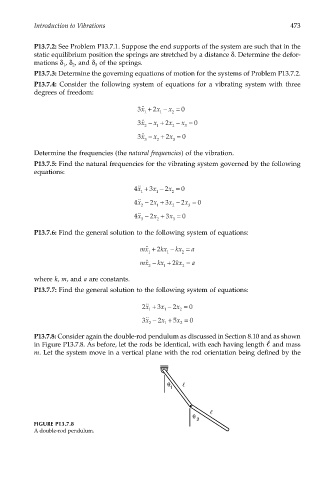Page 492 - Dynamics of Mechanical Systems
P. 492
0593_C13_fm Page 473 Monday, May 6, 2002 3:21 PM
Introduction to Vibrations 473
P13.7.2: See Problem P13.7.1. Suppose the end supports of the system are such that in the
static equilibrium position the springs are stretched by a distance δ. Determine the defor-
mations δ , δ , and δ of the springs.
3
2
1
P13.7.3: Determine the governing equations of motion for the systems of Problem P13.7.2.
P13.7.4: Consider the following system of equations for a vibrating system with three
degrees of freedom:
3˙˙ x + 2x − x = 0
1 1 2
3˙˙ x − x + 2x − x = 0
2 1 2 3
3˙˙ x − x + 2x = 0
3 2 3
Determine the frequencies (the natural frequencies) of the vibration.
P13.7.5: Find the natural frequencies for the vibrating system governed by the following
equations:
4˙˙ x + 3x − 2x = 0
1 1 2
4˙˙ x − 2x + 3x − 2x = 0
2 1 2 3
4˙˙ x − 2x + 3x = 0
3 2 3
P13.7.6: Find the general solution to the following system of equations:
mx ˙˙ + 2 kx − kx = a
1 1 2
mx ˙˙ − kx + 2 kx = a
2 1 2
where k, m, and a are constants.
P13.7.7: Find the general solution to the following system of equations:
2˙˙ x + 3x − 2x = 0
1
1
2
3˙˙ x − 2x + 5x = 0
2
2
1
P13.7.8: Consider again the double-rod pendulum as discussed in Section 8.10 and as shown
in Figure P13.7.8. As before, let the rods be identical, with each having length and mass
m. Let the system move in a vertical plane with the rod orientation being defined by the
θ
1
θ
2
FIGURE P13.7.8
A double-rod pendulum.

